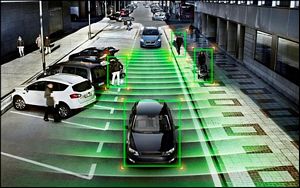|
By accessing or using The Crittenden Automotive Library™/CarsAndRacingStuff.com, you signify your agreement with the Terms of Use on our Legal Information page. Our Privacy Policy is also available there. |

Autonomous Cars And A Bucket Of Cold Water
|
|---|
|
|
Autonomous Cars And A Bucket Of Cold Water
Geoff Maxted
DriveWrite
October 21, 2013
The annual Intelligent Transportation Systems (ITS) World Congress met in Tokyo last week. The gathering was to discuss intelligent transportation systems and engineers and operators alike injected doses of realism about the hurdles ahead for such technologies and especially autonomous motors.
It was an ironic about-face for this meeting of minds. In years past, the congress was largely a platform for experts to tout the potential of intelligent transportation. But as self-driving cars have gained ground so those same experts have become the voices of caution.
The problems are plentiful. Even as companies such as Nissan, Tesla and Google race to unveil plans to develop autonomous cars by 2020 so the voice of reason grows louder.
The assembled experts reckoned that driverless vehicles faced these common issues - technical challenges, lack of industry standards, unclear or nonexistent regulations, the cost implications and last but by no means least, liability questions. In other words - in the event of an accident whose fault is it?
Consider the technical challenges to managing the massive streams of data being broadcast among vehicles and between vehicles and the infrastructure over Wi-Fi-like networks. Those systems, which could use telephone networks or a wireless communications channel called Dedicated Short-Range Communication, are considered key to a rollout.
But when a car drives down the street communicating with other vehicles and the roadside sensors that warn of blind curves, stray pedestrians and hidden obstacles, the vehicles are throwing out 1 gigabyte of data each minute over the wireless networks apparently and that’s a huge amount of data.
A demonstration drive through an ITS network set up along Tokyo's waterfront district showed big limitations. The signal, which was supposed to alert the driver to oblivious pedestrians or motorcycles in the car's blind spot, failed to trigger warnings in the Mitsubishi Outlander test vehicle. At other crowded intersections, the "Caution, Oncoming Vehicle" buzzer sounded -- but it was unclear about which vehicle the system was warning. It seems there is no one-size-fits-all solution. Car sensors have a hard time seeing around corners, into blind spots or miles down the road and their computers need to account for millions of driving scenarios.
The manufacturers should rein themselves in a bit and stop trying be the first to the street with this technology. Truly autonomous cars are a lot further away than we think.



















